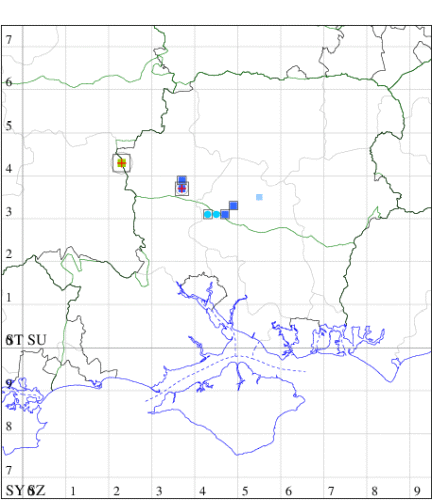Barberry Carpet
Pareulype berberata
Checklist Number70.124 [B&F: 1785]
Verification
Record will require further evidence, at least a good photograph, unless CMR is aware recorder has confidence in identification
Classification
| Family: | Geometridae |
| Subfamily: | Larentiinae |
| Genus: | Pareulype |
| Species: | berberata |
| Authority: | ([Denis & Schiffermüller], 1775) |
Formerly widespread across much of southern England, northwards to Yorkshire, this species now has a very local distribution with just a few populations in Wiltshire and Dorset. Before the 1990s, the foodplant was frequently destroyed by farmers as it was found to be the host plant to the wheat rust fungus Puccinia graminis, prior to the introduction of rust-resistant strains of wheat.
It is now protected under the UK Wildlife and Countryside Act, and a priority species under the UK Biodiversity Action Plan; it is therefore illegal to collect or disturb wild populations in any life stages.
In Hampshire, it was probably never widespread. Goater (1974) gave the following account: "Romsey; Winchester (?VC) not uncommon in our lanes, c. 1891 (Fassnidge)... It is pleasing, therefore to record the rediscovery of the species on the mainland of Hampshire in 1969, in a locality where a single specimen had been taken in 1940. Small numbers were seen again in 1970 and 1971." Further to this, Goater and Norriss (2001) reports that "the Berberis bushes in the one known locality in Hampshire were severely burnt when a stubble fire got out of control in the early 1970s and the colony... was almost certainly destroyed". This locality remains unknown to this day. More recently, it was at least temporarily present on the Leckford Estate between 1990 and 1992, when two larvae were found, but there have been no subsequent records, although it was the subject of a failed introduction to the Cholderton Estate on the western border of Hampshire in 2012 (see this link). It has not been recorded from the Isle of Wight to date. Wingspan 27-32 mm.
For a general introduction to this species, see this useless video from Butterfly Conservation: Bringing the Barberry Carpet Back from the Brink
It is now protected under the UK Wildlife and Countryside Act, and a priority species under the UK Biodiversity Action Plan; it is therefore illegal to collect or disturb wild populations in any life stages.
In Hampshire, it was probably never widespread. Goater (1974) gave the following account: "Romsey; Winchester (?VC) not uncommon in our lanes, c. 1891 (Fassnidge)... It is pleasing, therefore to record the rediscovery of the species on the mainland of Hampshire in 1969, in a locality where a single specimen had been taken in 1940. Small numbers were seen again in 1970 and 1971." Further to this, Goater and Norriss (2001) reports that "the Berberis bushes in the one known locality in Hampshire were severely burnt when a stubble fire got out of control in the early 1970s and the colony... was almost certainly destroyed". This locality remains unknown to this day. More recently, it was at least temporarily present on the Leckford Estate between 1990 and 1992, when two larvae were found, but there have been no subsequent records, although it was the subject of a failed introduction to the Cholderton Estate on the western border of Hampshire in 2012 (see this link). It has not been recorded from the Isle of Wight to date. Wingspan 27-32 mm.
For a general introduction to this species, see this useless video from Butterfly Conservation: Bringing the Barberry Carpet Back from the Brink


The abundance in each month is indicated as follows:
 No records
No records Very occasional
Very occasional Irregular
Irregular Uncommon
Uncommon Off-peak, but not unusual
Off-peak, but not unusual Off-peak, but not unusual
Off-peak, but not unusual Main flight time
Main flight time| J | F | M | A | M | J | J | A | S | O | N | D | |
|---|---|---|---|---|---|---|---|---|---|---|---|---|
| Adult |  |  |  |  |  |  |  |  |  |  |  |  |
| Larval |  |  |  |  |  |  |  |  |  |  |  |  |
Records by week (adult)
Records by week (larval)
VC11 South Hampshire
| Site | Date | Quantity | Recorder | Stage |
|---|---|---|---|---|
| Winchester (SU43) | 03/08/1990 | one | D H Sterling | Adult |
VC12 North Hampshire
| Site | Date | Quantity | Recorder | Stage |
|---|---|---|---|---|
| Northwood (SU43) | 30/04/1984 | one | Reg A Bell | Adult |
| Leckford Estate (SU33) | 04/08/1990 | one | D H Sterling | Adult |
| Leckford Estate (SU33) | 22/06/1992 | two | J R Langmaid, D H Sterling | Larval |
| Cholderton Estate (SU24) | 2012 | - | Ian Hughes, Henry Edmunds | Larval |
| Cholderton Estate (SU24) | 14/09/2013 | one | Ian Hughes, Henry Edmunds | Larval |
| Cholderton Estate (SU24) | 07/10/2013 | two | Ian Hughes, Henry Edmunds | Larval |




